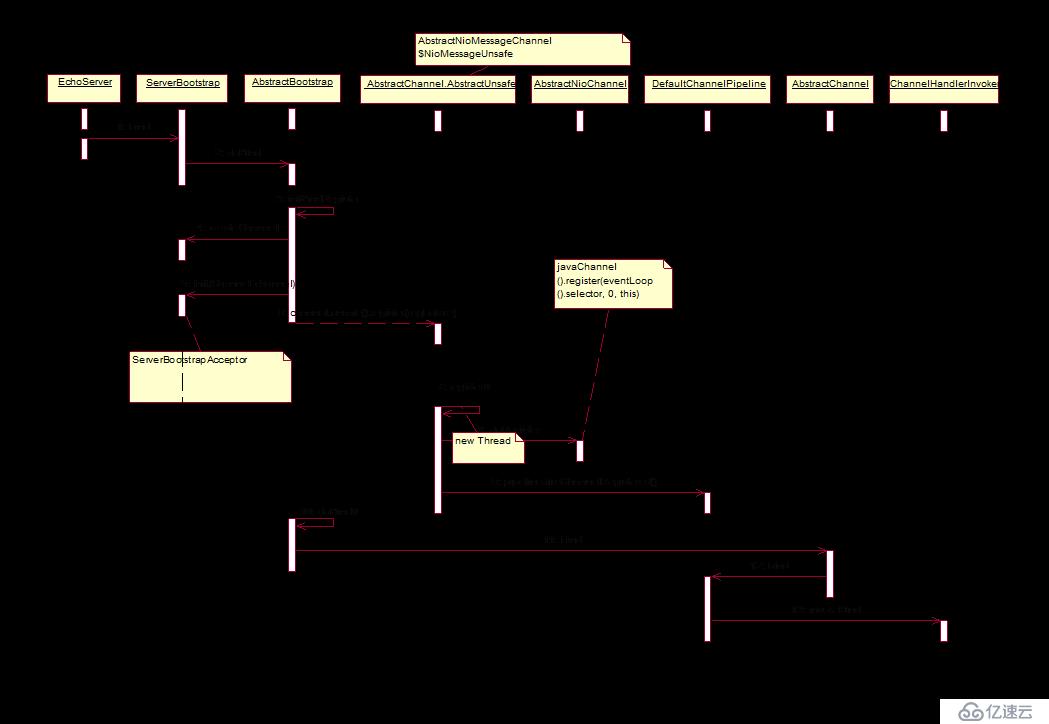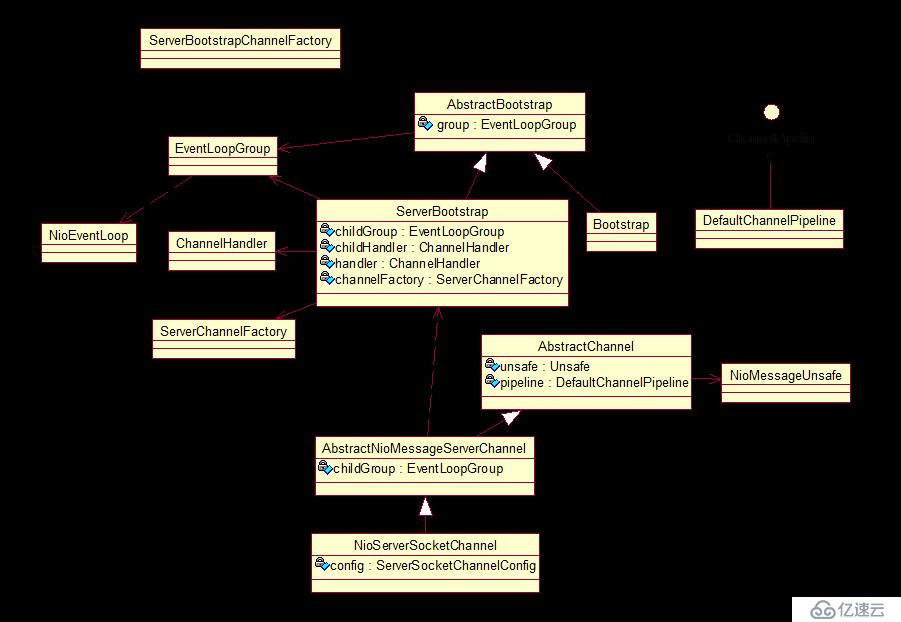参照《Netty系列之Netty 服务端创建》,研究了netty的服务端创建过程。至于netty的优势,可以参照网络其他文章。《Netty系列之Netty 服务端创建》是 李林锋撰写的netty源码分析的一篇好文,绝对是技术干货。但抛开技术来说,也存在一些瑕疵。
缺点如下
代码衔接不连贯,上下不连贯。
代码片段是截图,对阅读代理不便(可能和阅读习惯有关)
本篇主要内容,参照《Netty系列之Netty 服务端创建》,梳理出自己喜欢的阅读风格。
1.整体逻辑图
整体将服务端创建分为2部分:(1)绑定端口,提供服务过程;(2)轮询网络请求

1.1 绑定端口序列图

1.2 类图

类图仅仅涵盖了绑定过程中比较重要的几个组件
1.3 代码分析
step 2 doBind 绑定本地端口,启动服务
private ChannelFuture doBind(final SocketAddress localAddress) {
final ChannelFuture regFuture = initAndRegister();//1
final Channel channel = regFuture.channel();
if (regFuture.cause() != null) {
return regFuture;
}
final ChannelPromise promise;
if (regFuture.isDone()) {
promise = channel.newPromise();
doBind0(regFuture, channel, localAddress, promise);//2
} else {
// Registration future is almost always fulfilled already, but just in case it's not.
promise = new DefaultChannelPromise(channel, GlobalEventExecutor.INSTANCE);
regFuture.addListener(new ChannelFutureListener() {
@Override
public void operationComplete(ChannelFuture future) throws Exception {
doBind0(regFuture, channel, localAddress, promise);//2
}
});
}
return promise;
}主要分为2个处理单元
step3 initAndRegister
final ChannelFuture initAndRegister() {
Channel channel;
try {
channel = createChannel();
} catch (Throwable t) {
return VoidChannel.INSTANCE.newFailedFuture(t);
}
try {
init(channel);
} catch (Throwable t) {
channel.unsafe().closeForcibly();
return channel.newFailedFuture(t);
}
//注册NioServerSocketChannel到Reactor线程的多路复用器上
ChannelPromise regFuture = channel.newPromise();
channel.unsafe().register(regFuture);
if (regFuture.cause() != null) {
if (channel.isRegistered()) {
channel.close();
} else {
channel.unsafe().closeForcibly();
}
}
return regFuture;
}createChannel由子类ServerBootstrap实现,创建新的NioServerSocketChannel,并完成Channel初始化,以及注册。
4.ServerBootstrap.createChannel
Channel createChannel() {
EventLoop eventLoop = group().next();
return channelFactory().newChannel(eventLoop, childGroup);
}它有两个参数,参数1是从父类的NIO线程池中顺序获取一个NioEventLoop,它就是服务端用于监听和接收客户端连接的Reactor线程。第二个参数就是所谓的workerGroup线程池,它就是处理IO读写的Reactor线程组。
5.ServerBootstrap.init
void init(Channel channel) throws Exception {
//设置Socket参数和NioServerSocketChannel的附加属性
final Map<ChannelOption<?>, Object> options = options();
synchronized (options) {
channel.config().setOptions(options);
}
final Map<AttributeKey<?>, Object> attrs = attrs();
synchronized (attrs) {
for (Entry<AttributeKey<?>, Object> e: attrs.entrySet()) {
@SuppressWarnings("unchecked")
AttributeKey<Object> key = (AttributeKey<Object>) e.getKey();
channel.attr(key).set(e.getValue());
}
}
//将AbstractBootstrap的Handler添加到NioServerSocketChannel的ChannelPipeline中
ChannelPipeline p = channel.pipeline();
if (handler() != null) {
p.addLast(handler());
}
final ChannelHandler currentChildHandler = childHandler;
final Entry<ChannelOption<?>, Object>[] currentChildOptions;
final Entry<AttributeKey<?>, Object>[] currentChildAttrs;
synchronized (childOptions) {
currentChildOptions = childOptions.entrySet().toArray(newOptionArray(childOptions.size()));
}
synchronized (childAttrs) {
currentChildAttrs = childAttrs.entrySet().toArray(newAttrArray(childAttrs.size()));
}
//将用于服务端注册的Handler ServerBootstrapAcceptor添加到ChannelPipeline中
p.addLast(new ChannelInitializer<Channel>() {
@Override
public void initChannel(Channel ch) throws Exception {
ch.pipeline().addLast(new ServerBootstrapAcceptor(currentChildHandler, currentChildOptions,
currentChildAttrs));
}
});
}到此处,Netty服务端监听的相关资源已经初始化完毕。
6.AbstractChannel.AbstractUnsafe.register
public final void register(final ChannelPromise promise) {
//首先判断是否是NioEventLoop自身发起的操作,如果是,则不存在并发操作,直接执行Channel注册;
if (eventLoop.inEventLoop()) {
register0(promise);
} else {//如果由其它线程发起,则封装成一个Task放入消息队列中异步执行。
try {
eventLoop.execute(new Runnable() {
@Override
public void run() {
register0(promise);
}
});
} catch (Throwable t) {
logger.warn(
"Force-closing a channel whose registration task was not accepted by an event loop: {}",
AbstractChannel.this, t);
closeForcibly();
closeFuture.setClosed();
promise.setFailure(t);
}
}
}7.register0
private void register0(ChannelPromise promise) {
try {
// check if the channel is still open as it could be closed in the mean time when the register
// call was outside of the eventLoop
if (!ensureOpen(promise)) {
return;
}
doRegister();
registered = true;
promise.setSuccess();
pipeline.fireChannelRegistered();
if (isActive()) {//完成绑定时,不会调用该代码段
pipeline.fireChannelActive();
}
} catch (Throwable t) {
// Close the channel directly to avoid FD leak.
closeForcibly();
closeFuture.setClosed();
if (!promise.tryFailure(t)) {
logger.warn(
"Tried to fail the registration promise, but it is complete already. " +
"Swallowing the cause of the registration failure:", t);
}
}
}触发事件
8.doRegister
protected void doRegister() throws Exception {
boolean selected = false;
for (;;) {
try {
//将NioServerSocketChannel注册到NioEventLoop的Selector上
selectionKey = javaChannel().register(eventLoop().selector, 0, this);
return;
} catch (CancelledKeyException e) {
if (!selected) {
// Force the Selector to select now as the "canceled" SelectionKey may still be
// cached and not removed because no Select.select(..) operation was called yet.
eventLoop().selectNow();
selected = true;
} else {
// We forced a select operation on the selector before but the SelectionKey is still cached
// for whatever reason. JDK bug ?
throw e;
}
}
}
}大伙儿可能会很诧异,应该注册OP_ACCEPT(16)到多路复用器上,怎么注册0呢?0表示只注册,不监听任何网络操作。这样做的原因如下:
注册方法是多态的,它既可以被NioServerSocketChannel用来监听客户端的连接接入,也可以用来注册SocketChannel,用来监听网络读或者写操作;
通过SelectionKey的interestOps(int ops)方法可以方便的修改监听操作位。所以,此处注册需要获取SelectionKey并给AbstractNioChannel的成员变量selectionKey赋值。
免责声明:本站发布的内容(图片、视频和文字)以原创、转载和分享为主,文章观点不代表本网站立场,如果涉及侵权请联系站长邮箱:is@yisu.com进行举报,并提供相关证据,一经查实,将立刻删除涉嫌侵权内容。